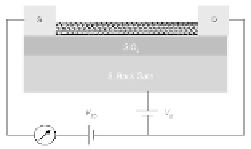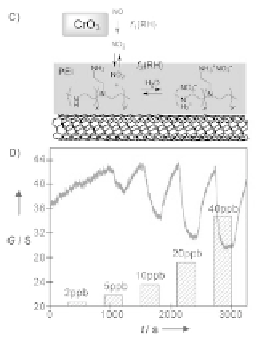Biomedical Engineering Reference
In-Depth Information
silicon dioxide, while the central region of nanotubes was exposed to
gas molecules. The devices with conductance channel length of 300
and 900 nm were partially coated with polyethyleneimine (PEI) and
tested toward NH
. Ammonia caused similar responses in passivated
and nonpassivated devices. The authors concluded that the length
of the covered nanotubes was comparable to the decay length of the
depletion charge in the nanotube transistors. This was important for
design of the CNTFET devices because the chemical sensitivity could
be affected by local chemical doping in a device.
3
Figure 9.35
(
) Schematic diagram of a nanotube FET device with
metal electrodes and Si back-gate. (
Left
c-Right
) Mechanism
diagram of NO into NO
conversion using a CrO
converter
2
3
and detection with PEI-coated CNTFET. (
) Response
of PEI-coated CNFET to NO gas, in the range from 2 to 40 ppb,
under N
d-Right
, with a 5 ppb detection limit. Gate voltage was of
0 V. This figure is reprinted and adapted with permission
from IOP [272].
2
Kuzmych
. [272] demonstrated a chemically functionalized
CNTFET for nitric oxide (NO) gas detection. The NO gas to be detected
was passed through acidic gas scrubbing, oxidation, and conductivity
measurements by CNTFET. Gas mixtures containing NO were passed
through an Ascarite scrubber and then an oxidizing material (CrO
et al
)
3
which converted NO to NO
. This gas was delivered to the CNTFET
modified with PEI polymer. Interaction of NO gas with PEI-modified
CNTFET resulted in a conductivity change depending proportionally
on NO gas concentration, as shown in Fig. 9.35. A wide range of NO
2




